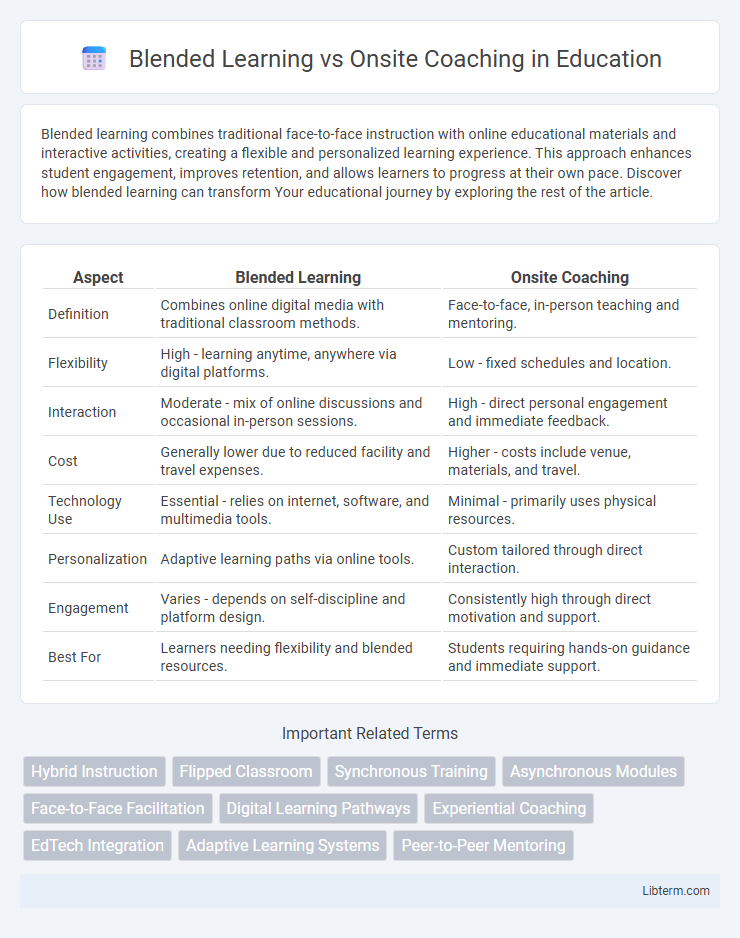Blended learning combines traditional face-to-face instruction with online educational materials and interactive activities, creating a flexible and personalized learning experience. This approach enhances student engagement, improves retention, and allows learners to progress at their own pace. Discover how blended learning can transform Your educational journey by exploring the rest of the article.
Table of Comparison
| Aspect | Blended Learning | Onsite Coaching |
|---|---|---|
| Definition | Combines online digital media with traditional classroom methods. | Face-to-face, in-person teaching and mentoring. |
| Flexibility | High - learning anytime, anywhere via digital platforms. | Low - fixed schedules and location. |
| Interaction | Moderate - mix of online discussions and occasional in-person sessions. | High - direct personal engagement and immediate feedback. |
| Cost | Generally lower due to reduced facility and travel expenses. | Higher - costs include venue, materials, and travel. |
| Technology Use | Essential - relies on internet, software, and multimedia tools. | Minimal - primarily uses physical resources. |
| Personalization | Adaptive learning paths via online tools. | Custom tailored through direct interaction. |
| Engagement | Varies - depends on self-discipline and platform design. | Consistently high through direct motivation and support. |
| Best For | Learners needing flexibility and blended resources. | Students requiring hands-on guidance and immediate support. |
Introduction to Blended Learning and Onsite Coaching
Blended learning combines digital media with traditional classroom methods, enhancing flexibility and personalized instruction through online platforms and face-to-face interactions. Onsite coaching emphasizes direct, in-person guidance where coaches provide real-time feedback and hands-on support, fostering immediate skill development. Both approaches aim to optimize learning outcomes by integrating effective teaching strategies suited to diverse learner needs.
Key Features of Blended Learning
Blended learning combines online digital resources with traditional face-to-face instruction, offering flexible scheduling and personalized learning paths that enhance student engagement and retention. Key features include interactive multimedia content, real-time feedback through digital assessments, and the integration of collaboration tools that facilitate peer interaction and instructor support. This approach supports diverse learning styles and provides scalable solutions that adapt to various educational settings and learner needs.
Core Characteristics of Onsite Coaching
Onsite coaching emphasizes face-to-face interaction, immediate feedback, and personalized support, creating a dynamic learning environment tailored to individual needs. It leverages physical presence to foster deeper engagement through hands-on activities and real-time collaboration. This core characteristic enables learners to build practical skills and professional relationships more effectively than remote alternatives.
Advantages of Blended Learning
Blended learning combines online digital resources with traditional face-to-face instruction, offering greater flexibility and personalized pacing that enhances learner engagement and retention. It provides access to a wide range of interactive content and assessments, facilitating continuous feedback and skill development beyond the limits of onsite coaching. This approach reduces travel time and costs while enabling scalable training solutions suited for diverse learning styles and geographical locations.
Benefits of Onsite Coaching
Onsite coaching provides personalized, face-to-face interaction that enhances communication and immediate feedback, fostering a deeper understanding of the material. It enables tailored learning experiences adapted to individual needs, promoting higher engagement and motivation. Physical presence also encourages accountability and collaborative learning, resulting in improved skill retention and performance.
Challenges of Blended Learning
Blended learning presents challenges such as technological barriers, inconsistent internet access, and varying levels of digital literacy among learners, which can hinder effective engagement. The need to balance online and face-to-face components often results in scheduling conflicts and reduced interaction quality. Additionally, instructors must invest significant time in designing cohesive curricula that seamlessly integrate both modalities.
Limitations of Onsite Coaching
Onsite coaching faces limitations such as restricted access to expert instructors, especially for those in remote locations or with tight schedules. The need for physical presence can increase costs related to travel, accommodation, and venue rental, reducing overall learning efficiency. Limited flexibility in pacing and content customization hinders learners from tailoring the experience to their individual needs compared to blended learning models.
Learning Outcomes: A Comparative Analysis
Blended learning combines online digital media with traditional classroom methods, resulting in improved learning outcomes through personalized pacing and interactive content, which caters to diverse learner needs. Onsite coaching facilitates immediate feedback and hands-on experiences, enhancing skill acquisition and retention in practical scenarios. Comparative studies indicate blended learning often leads to higher knowledge retention and flexibility, while onsite coaching excels in developing soft skills and real-time problem-solving abilities.
Best Practices for Implementation
Blended learning combines online educational materials with traditional onsite coaching, maximizing flexibility and engagement by leveraging digital tools and face-to-face interactions. Best practices for implementation include tailoring content to individual learner needs, ensuring seamless integration of technology with in-person sessions, and continuously monitoring learner progress through analytics and feedback. Effective scheduling, clear communication of expectations, and providing robust technical support also enhance the overall learning experience and improve retention rates.
Choosing the Right Approach for Your Needs
Selecting between blended learning and onsite coaching depends on factors such as learning style, schedule flexibility, and interaction preferences. Blended learning offers a combination of online and in-person sessions, enhancing accessibility and personalized pacing. Onsite coaching provides immersive, hands-on guidance ideal for skills requiring direct feedback and real-time collaboration.
Blended Learning Infographic

 libterm.com
libterm.com